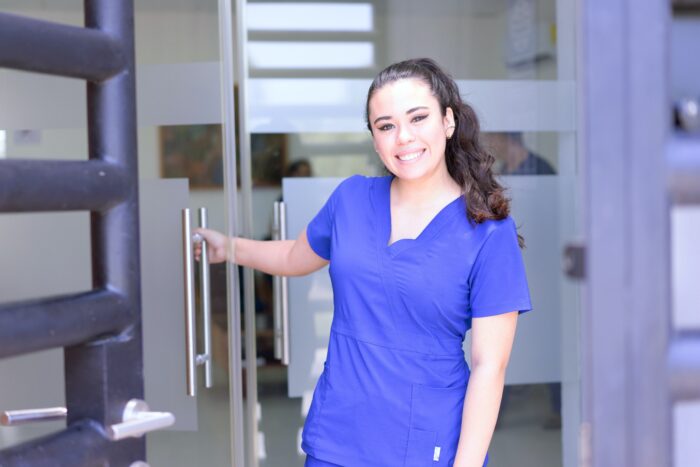If you wish to enter the healthcare industry without many educational requirements, medical assistance might be your best career.
Even though most states do not require medical assistants to be registered or licensed, employers highly prefer candidates who are certified. Obtaining your medical assistant certification also helps you earn more and get a job easily.
So what is a Registered Medical Assistant (RMA)?
A Registered Medical Assistant (RMA) is a certified medical assistant who has earned their license from the American Medical Technologists (AMT).
Read on to learn everything you need about RMAs, what they do, how much they earn, and how you can become one.
Also read: What is a Medical Assistant?
Read more: 12 Reasons to Become a Medical Assistant
AMT and RMA Certifications: An Overview
AMT, or American Medical Technologists, is a certification agency that sets certification standards, develops certification examinations, and offers continuing education programs for
medical laboratory technicians, phlebotomists, registered medical assistants, and other related professions.
Obtaining RMA certification through AMT demonstrates your dedication to performing well as a medical assistant to potential employers. Holding this certification can make it easier to secure employment and potentially result in a higher salary.
Registered Medical Assistants (RMAs) typically work in healthcare settings such as doctor’s offices and clinics, where they work collaboratively with physicians to provide patient care and manage administrative tasks.
Their responsibilities may include preparing patients for exams, administering injections, answering phones, scheduling appointments, and managing billing.
Also see: Medical Assistant Certificate Requirements
To become an RMA, one must pass an exam covering anatomy, physiology, medical assistant terminology, and other fundamental areas of patient care.
Read more on: Medical Assistant Job Duties
How To Become a Registered Medical Assistant?
To become a registered medical assistant, the time it takes can range from a few weeks to several months, depending on your prior experience and the educational program you choose.
See: Medical Assistant Educational Requirements
Before you can take the RMA exam, there are specific requirements that you need to meet. If you already meet them, you can take the exam and become an RMA.
However, if you don’t meet the requirements, you will have first to complete an approved training program or gain relevant work experience.
Here is a step-by-step guide on how to become a medical assistant:
1. Obtain your high school diploma or a GED
The general prerequisite to becoming a medical assistant is to complete your high school diploma or a GED.
2. Ensure you are qualified to take the RMA Exam
You can take three main routes to become eligible for the RMA exam: completing an accredited medical assisting program, completing a US Armed Forces medical assisting program, or having work experience as a medical assistant for at least three years in the past seven years.
Also see: Medical Assistant Programs Cost
You can also become eligible for the RMA exam by working as a medical assistant instructor for at least 5 years or by working as a medical assistant instructor for at least 1 year and having at least 3 years of work experience in another healthcare position.
3. Apply for the RMA Exam
After meeting the eligibility requirements, the next step to becoming an RMA is to apply for the RMA exam.
You can do this by creating an account on the AMT website and going to the RMA section. Then, choose the section that corresponds to the eligibility requirements you have met and select “Apply Now.”
You will need to complete the application and pay a fee of $120 for the examination.
4. Schedule your exam
Once you have received authorization to test, you can schedule your RMA exam. Pearson VUE, an online testing platform, offers different testing options, such as finding a testing center near you or taking the exam from home.
If you choose to take the exam from home, a remote proctor will monitor you via webcam while you take your exam.
5. Study and sit for your exam
Many resources, such as online practice tests and study guides, can help you review the material. This is especially important if you have not recently completed a medical assisting program.
The RMA exam consists of 200 questions and covers anatomy, physiology, medical terminology, patient care, and administrative tasks. With adequate preparation and study, you can feel confident and prepared on the day of your exam.
Also see: Accelerated Medical Assistant Program
6. Maintain your certification
You must complete 30 continuing certification points (CCPs) every three years to maintain your RMA certification. These CCPs can be earned through various activities, such as attending conferences, taking continuing education courses, or publishing articles.
You will also need to pay a $60 annual fee to keep your certification active.
Also read: Which medical assistant certification is the best?
RMA Exam: Structure & Requirements to Pass The Exam
During the RMA exam, you will be required to answer 210 multiple-choice questions within two hours.
It is important to note that you cannot bring any materials such as cheat sheets or calculators with you to the exam. However, all the necessary materials will be provided for you.
The general topics covered in the RMA exam are:
What Are The Requirements to Pass the RMA Exam?
To successfully pass the RMA exam, it is necessary to correctly answer at least 147 out of the 210 multiple-choice questions, achieving a minimum passing score of 70%.
You will have a time limit of 2 hours to complete the test, during which you are not allowed to use cheat sheets or calculators, but all necessary materials will be provided to you.
How Much Does the RMA Exam Cost?
To take the RMA exam for the first time, you will need to pay a fee of $120. If you do not pass the exam and need to retake it, the fee is $90. Additionally, to maintain your certification each year, you must pay a renewal fee of $60.
How To Prepare for the RMA Exam? Cheapest Medical Assistant Program
To prepare for the RMA exam, it’s recommended to take practice tests and use study resources such as Quizlet and online instructional videos. On the exam day, getting a good night’s rest and eating a healthy meal beforehand is important.
It’s also advisable to wear comfortable clothing with removable layers in case of temperature changes. Arriving at the testing center at least 30 minutes early allows time for parking, restroom breaks, and settling in.
Being more than 15 minutes late will result in not being allowed to take the exam. If you require special accommodations such as break periods or extended testing time, you can request them from the AMT in advance.
See: Cheapest Medical Assistant Program
Also read: Are Medical Assistant Licenses Required?

Do You Want To Become a Medical Assistant? Check Out Free Medical Assistant Masterclass!
In our masterclass you learn:
- How to be a medical assistant faster…in just 4 months!
- Avoid student debt & driving to classes
- #1 thing employers want from Medical Assistants
- How to stand-apart & get a university certificate for a strong resume
What is a Registered Medical Assistant (RMA) + Duties
A registered medical assistant is a healthcare worker who has obtained a certification in medical assisting. Medical assistants typically work in medical offices and clinics, but they can also be found in hospitals, outpatient centers, and long-term care facilities.
Registered medical assistants collaborate with doctors to provide patient care. They are typically responsible for both clinical and administrative duties.
Clinical Duties
- Taking and recording vital signs such as blood pressure, temperature, and pulse
- Preparing patients for examinations, treatments, and procedures
- Assisting physicians during examinations and treatments
- Administering medications as directed by the physician
- Collecting and preparing laboratory specimens for testing
- Performing basic laboratory tests such as urinalysis and blood glucose testing
- Providing patient education and answering questions about health conditions and treatments
- Performing electrocardiograms (EKGs) and other diagnostic tests.
Also see: Can Medical Assistants Draw Blood?
Administrative Duties
- Greeting patients and scheduling appointments
- Answering phone calls and responding to emails
- Updating patient records and medical histories
- Filling out insurance forms and verifying insurance coverage
- Handling billing and coding procedures
- Managing inventory and ordering medical supplies
- Maintaining a clean and organized work environment.
Also read: Certified Clinical Medical Assistant (CCMA)
Registered Medical Assistant: Salary and Job Outlook
On average, medical assistants make around $37,190 annually, equivalent to about $18 per hour. It’s worth noting that registered medical assistants could potentially earn more since the average figure also includes non-certified professionals.
The medical assistant job outlook is promising, with an anticipated growth rate of 16% through 2031. This is significantly higher than the average growth rate for all occupations in the United States, mainly due to the aging baby boomer population and the growing demand for healthcare services.
As the healthcare industry continues to expand, medical assistants are expected to play an increasingly crucial role in delivering high-quality patient care.
Also read: Certified Medical Assistant Salary
Conclusion
The role of a registered medical assistant stands as a cornerstone in healthcare. With their extensive training and certification, these professionals bring a wealth of skills to medical settings.
From providing essential patient care to managing administrative duties, their expertise ensures smooth operations in clinics, hospitals, and doctors’ offices. Their commitment to professionalism and patient well-being highlights their invaluable contribution to the healthcare team.
Related Resources:
- How Long Does It Take to Become a Medical Assistant
- CMA vs CNA
- CMAA vs CCMA
- How To Get Medical Assistant Jobs With No Experience
- Types of Medical Assistants
- Military Medical Assistant
- Medical Assistant On-the-Job Training
- Medical Assistant vs EMT
- National Certified Medical Assistant NCMA
- Medical Assistant Degree Online 6 Weeks
- 4 Week Medical Assistant Program
Related Articles
-
How to Be Successful in College in 2022 – 7 Simple Tips to Succeed
-
How Do Scholarships Work? Read This First…Truth is Shocking
-
7 Best College Majors 2024: What Should I Major In?
-
How to Choose a College – 10 Things You Must Consider in 2024
-
Why Go to College? Top 13 Benefits for Adult Students in 2022
-
Top 5 Best Alternatives to Community College for 2024











